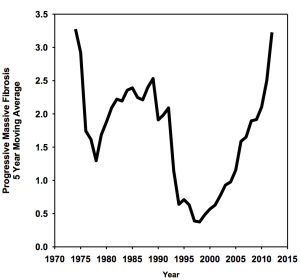ACLC Featured in Local and National Press Coverage of Severe Black Lung Resurgence
New research from the National Institute of Occupational Safety and Health (NIOSH) has found that the rate of the most severe form of black lung among Appalachian coal miners has resurged to the same rate it was before the federal government started regulating coal mine dust levels 45 years ago.
As we wrote on our black lung blog, Devil in the Dust,
The takeaway from this new data is probably best conveyed in a chart, shown below, that shows the U-shaped curve of PMF rates. While the chart itself is appalling, what’s worse is that it shows five-year moving averages. Therefore the recent raw numbers are even more grim and show that the risk of catching severe black lung is actually worse for miners today than it was in 1969.

The research has received significant coverage in local and national press outlets featuring commentary from ACLC staff. ACLC Deputy Director Wes Addington told the Louisville Courier-Journal, “This data is truly frightening. A decade ago it would have been unimaginable that we would see rates of severe black lung back up to 1960s levels. We have broken our promise to protect our miners.”
WFPL-Louisville and WYMT-TV in Hazard featured ACLC attorney Evan Smith. “What we’ve seen since especially the ’80s is that there’s been under-enforcement of the rules, there’s been major loopholes that have meant that even if you look at the book and say ‘this is what the dust level is,’ that’s not what miners have been exposed to,” Smith told WFPL. “The mix of dust they’re being exposed to isn’t as much as pure coal as what maybe my grandfather would have been breathing. Instead there’s a lot more rock, sandstone, shale. And what’s in those rocks ends up being more damaging to miners’ lungs.”
Coverage of the story has also been featured in Think Progress (along with a quote from our board member Stanley Sturgill), the Lexington Herald-Leader, Buzzfeed, the Center for Public Integrity, and The Wall Street Journal.
This appalling data comes amid findings that miners at small mines are more at risk of getting black lung than miners at large mines, and calls to reform the complex bureaucratic system that makes it hard for miners to receive black lung benefits.
With black lung rates on the rise in Appalachia, and a system that pours millions of dollars and resources into defeating benefits claims, our work is now more important than ever. Please consider a donation. Your continued support helps ensure that miners suffering from black lung disease are represented at every step in the legal process.

Recent Comments